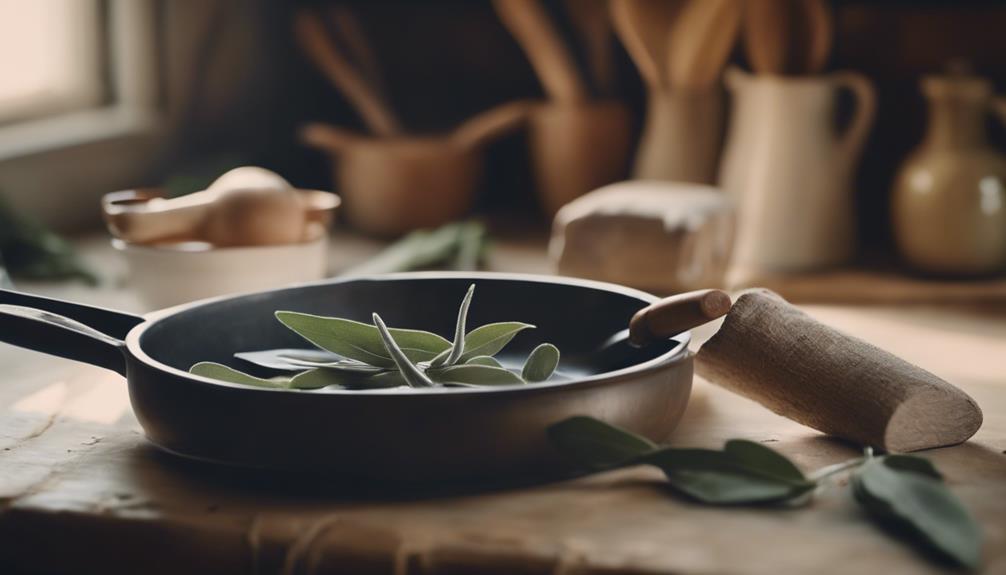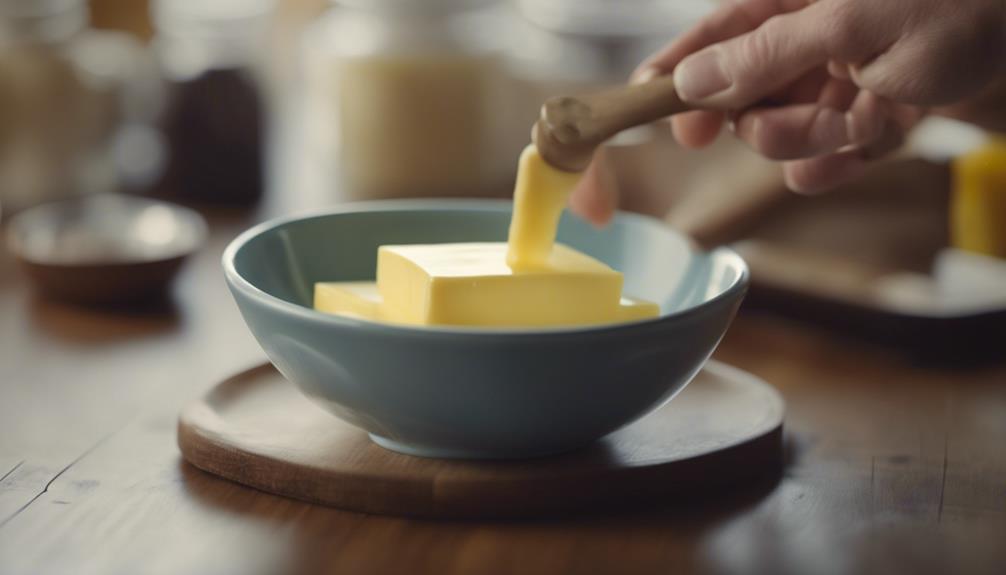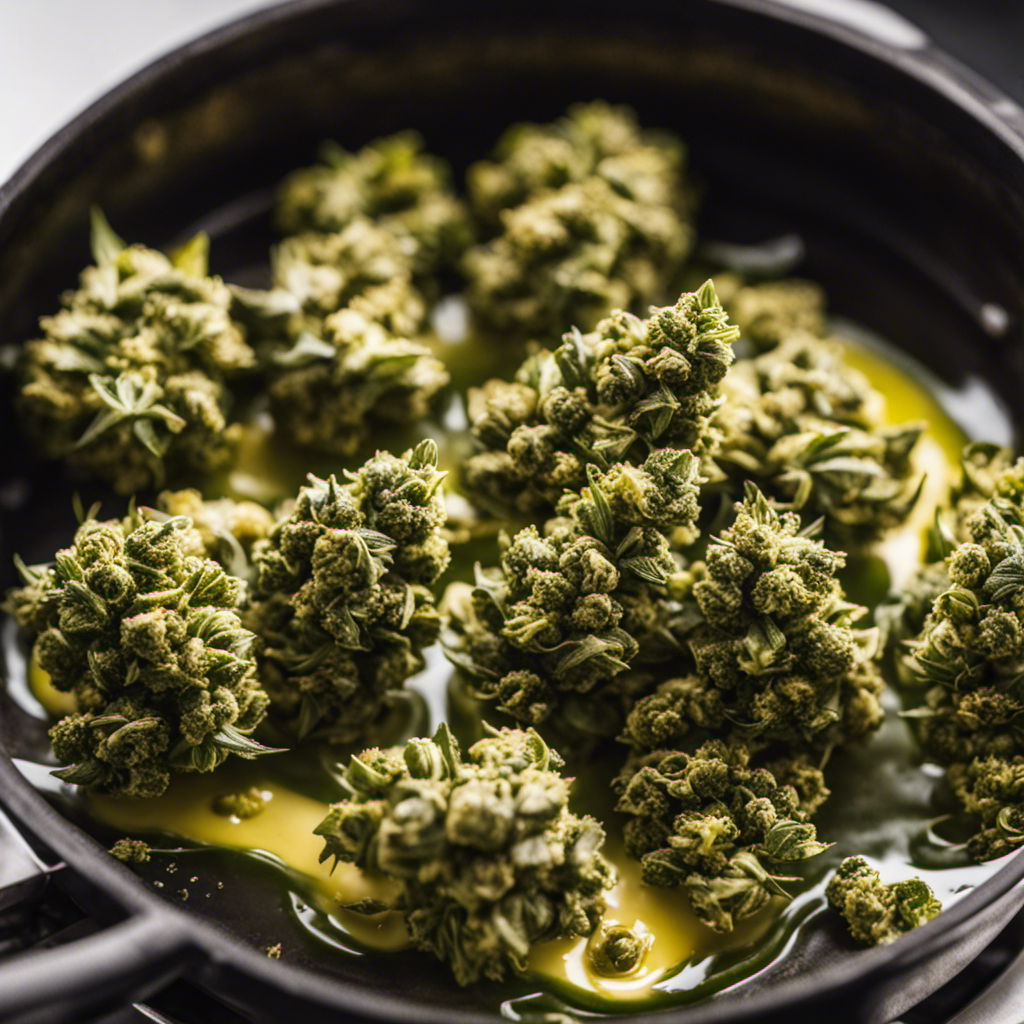Enhance your dishes with the earthy, aromatic taste of sage butter. Start by softening butter to room temperature and finely mincing fresh sage leaves. Mix the sage into the butter with a pinch of salt and pepper. Mold into a desired shape and refrigerate. Use this flavorful butter to elevate roasted vegetables, spread on warm bread, or top off pasta dishes. For long-term storage, freeze in pats or logs. You can get creative by adding herbs like rosemary or spices like red pepper flakes for unique variations. Curious how else you can utilize sage butter? Let's explore more.
Key Takeaways
- Soften unsalted butter to room temperature for easy mixing.
- Finely mince fresh, aromatic sage leaves to maximize flavor.
- Combine softened butter with minced sage, salt, and pepper until evenly blended.
- Refrigerate the mixture for at least an hour to intensify flavors.
- Experiment with additional herbs or ingredients like garlic, parmesan, or lemon zest for unique variations.
Ingredients Needed
To make sage butter, you'll need just a few simple ingredients: softened butter, finely minced sage leaves, salt, and pepper. The beauty of sage butter lies in its simplicity and the richness it brings to various dishes.
Start with about half a cup of softened butter; it should be soft enough to mix easily but not melted. This texture allows the other ingredients to blend seamlessly.
The next key ingredient is sage. You'll want to use fresh sage leaves and finely mince them. Finely mincing is pivotal because it helps release the aromatic oils that give sage butter its distinctive flavor. Aim for about two tablespoons of minced sage leaves, but you can adjust based on your preference.
Don't forget the seasoning! A pinch of salt and a dash of white pepper can elevate the flavors, making the butter even more irresistible. While these are optional, they add a nice touch of complexity that complements the sage.
Once you have all these ingredients, you're ready to mix them. The resulting sage butter can then be used immediately or stored for future culinary adventures.
Step-by-Step Instructions
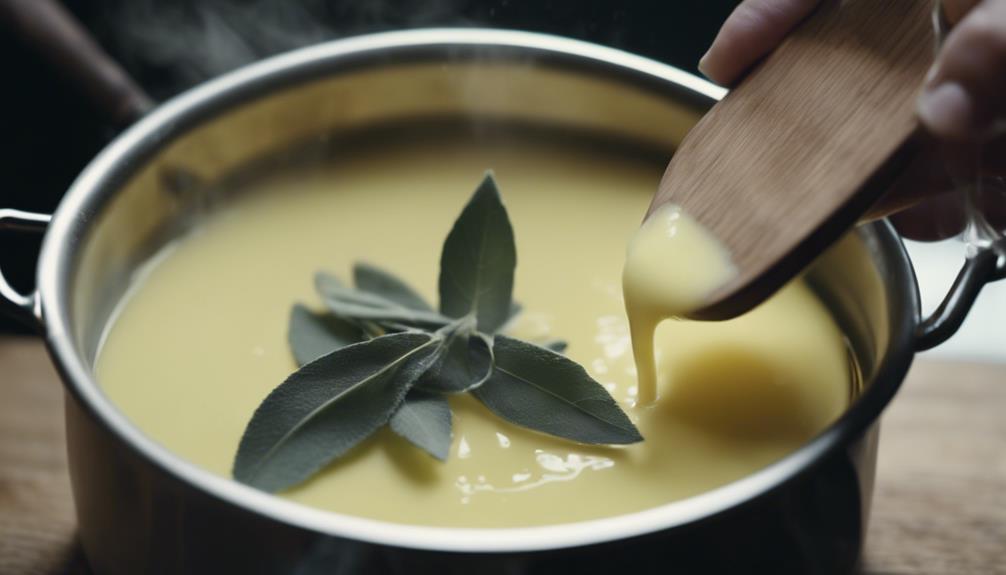
Begin by making sure the butter is softened to room temperature for easy mixing.
Next, finely mince the sage leaves to release their full flavor. If you want an extra layer of depth, you can create browned butter by heating the butter in a pan until it takes on a golden hue and a nutty aroma. Let the browned butter cool to room temperature before proceeding.
Now, combine the softened butter (or cooled browned butter) with the minced sage leaves. Add a pinch of salt and pepper to taste. Mix thoroughly to guarantee an even distribution of the sage and seasoning throughout the butter.
Once everything is well combined, transfer the sage butter mixture into a container or shape it into a log using parchment paper. Refrigerate the mixture overnight. This resting period allows the flavors to meld and intensify, resulting in a richer, more aromatic butter.
Your sage butter is now ready to use. Drizzle it over vegetables, spread it on freshly baked bread, or enhance the flavor of your favorite dishes.
Don't hesitate to experiment with different herbs or spices to create your own flavorful variations. Enjoy the aromatic and delicious boost it brings to your meals!
Freezing and Storage Tips
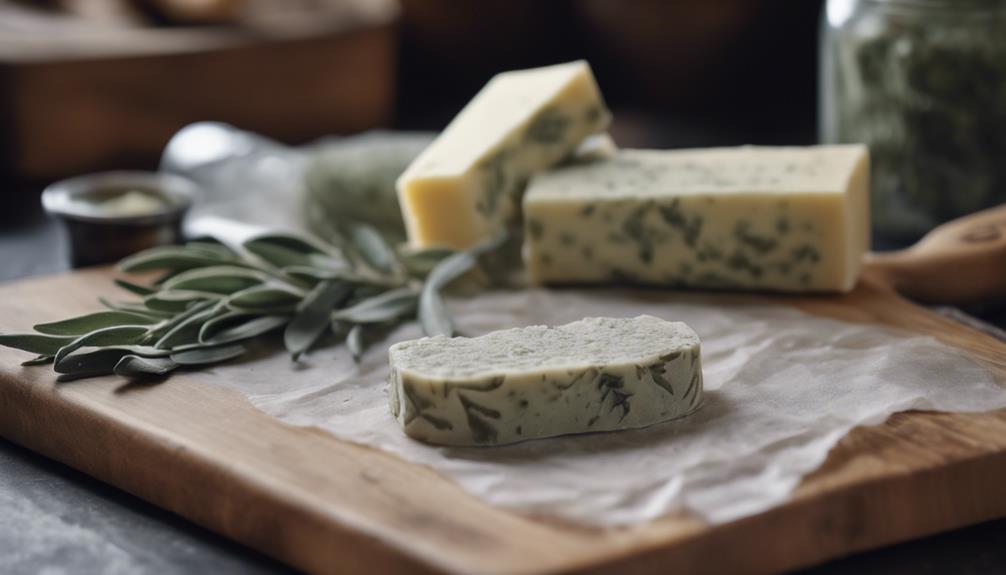
After you've prepared your sage butter, proper freezing and storage will safeguard it stays fresh and flavorful for future use.
To start, decide if you want to freeze sage butter in a tube or as individual pats. Forming it into a tube makes slicing off the exact amount you need a breeze, while individual pats are perfect for easy portioning.
Once you've chosen your preferred method, wrap the butter and sage mixture tightly in plastic wrap or parchment paper, making sure no air gets in. Next, place the wrapped sage butter into a zip-lock bag to provide an extra layer of protection against freezer burn. Label the bag with the date and contents so you can keep track of its freshness.
When you're ready to use your frozen sage butter, take out the amount you need and let it soften at room temperature. This will make it easier to spread or incorporate into your favorite dishes.
By following these storage tips, your sage butter will maintain its delicious flavor and be ready to elevate any meal at a moment's notice.
Serving Suggestions
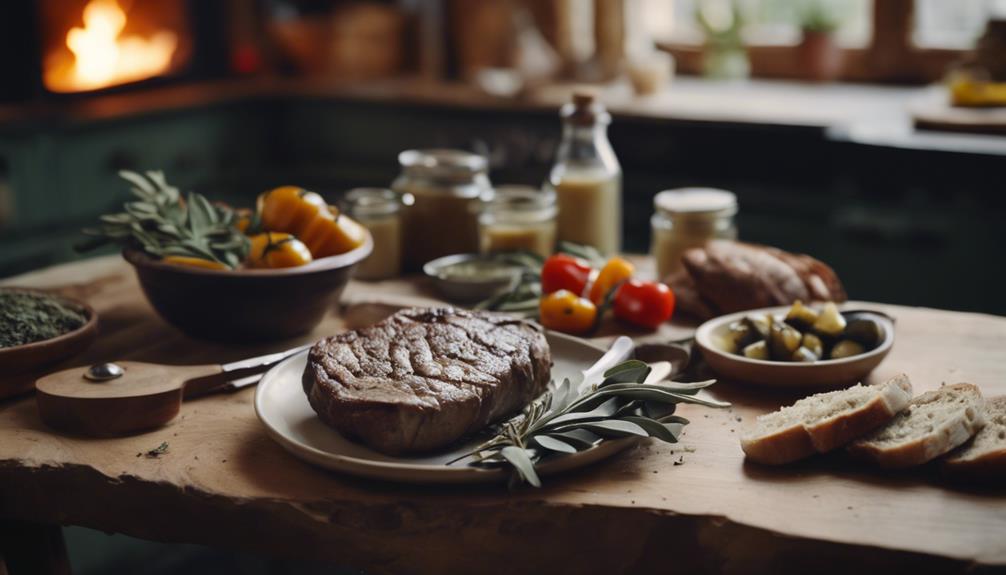
When considering how to use your sage butter, think about pairing it with roasted vegetables, fresh bread, or pasta dishes.
It's especially delightful with pumpkin ravioli, offering a rich, aromatic touch.
Don't hesitate to experiment with seasonal recipes and different herbs to suit your taste.
Ideal Pairing Dishes
Sage butter transforms ordinary meals into extraordinary dining experiences, pairing perfectly with dishes like butternut squash ravioli, roasted chicken, and grilled pork chops. Imagine the earthy, herbaceous flavor of sage butter mingling with the sweet, creamy filling of butternut squash ravioli; it's a match made in culinary heaven. When drizzled over roasted chicken, the sage-infused butter sauce enhances the savory notes, creating a rich, mouthwatering bite. Grilled pork chops also benefit immensely from this flavorful addition, with the sage butter adding a delightful layer of complexity.
Classic Italian dishes like pumpkin gnocchi and cappellacci di zucca become even more irresistible with a generous spoonful of sage butter. The butter's earthy undertones perfectly complement the natural sweetness of these pumpkin-based pastas. Sage butter also elevates traditional veal ossobuco, adding a fragrant, buttery finish to the slow-cooked meat.
For risotto alla zucca, sage butter brings out the dish's creamy texture and deepens its flavor profile. And don't forget saltimbocca; a simple drizzle of sage butter can turn this already delicious dish into a gourmet experience. Try spreading sage butter on bread or toast for a unique, flavorful twist.
Versatile Cooking Uses
The versatility of sage butter allows you to elevate a wide range of dishes with its rich, aromatic flavor. You'll be amazed at how this simple condiment can transform your meals.
For a start, try drizzling it over a tray of roasted vegetables. The sage butter will infuse the veggies with a delightful, nutty essence, creating a memorable side dish.
Sage butter also works wonders when used as a brown butter sage sauce for pasta dishes. Just save a bit of pasta water to mix in, helping to create a smooth, cohesive sauce that clings perfectly to each strand. This technique is particularly delicious with pumpkin ravioli, adding a hint of savory depth to the sweet, creamy filling.
Here are some other delicious ways to use sage butter:
- Spread it on bread or toast: A simple yet flavorful snack or side that pairs well with soups and salads.
- Drizzle over grilled meats: Enhance the taste of your favorite cuts with a melt-in-your-mouth finish.
- Incorporate into mashed potatoes: Elevate this classic comfort food with an aromatic twist.
Seasonal Recipe Ideas
As the seasons change, sage butter can be the perfect addition to your dishes, bringing warmth and flavor to your table.
For an easy recipe that impresses, try drizzling sage butter over roasted vegetables. The rich, nutty notes of the brown butter sauce combined with fresh sage can elevate even simple carrots or Brussels sprouts to gourmet status.
Spread sage butter on warm bread or toast for a flavorful touch that's perfect for cozy breakfasts or quick snacks. The herb-infused butter melts into the bread, creating a deliciously aromatic experience.
For a truly autumn-inspired dish, pair sage butter with pumpkin ravioli. The savory butter enhances the sweet and earthy flavors of the pumpkin, making each bite a harmonious blend of seasonal tastes. You'll be amazed at how this simple addition can turn a regular meal into a festive feast.
Using sage butter as a finishing touch can enhance the flavor of various dishes, from grilled meats to pasta. Its versatility makes it a must-have in your kitchen.
Recipe Variations
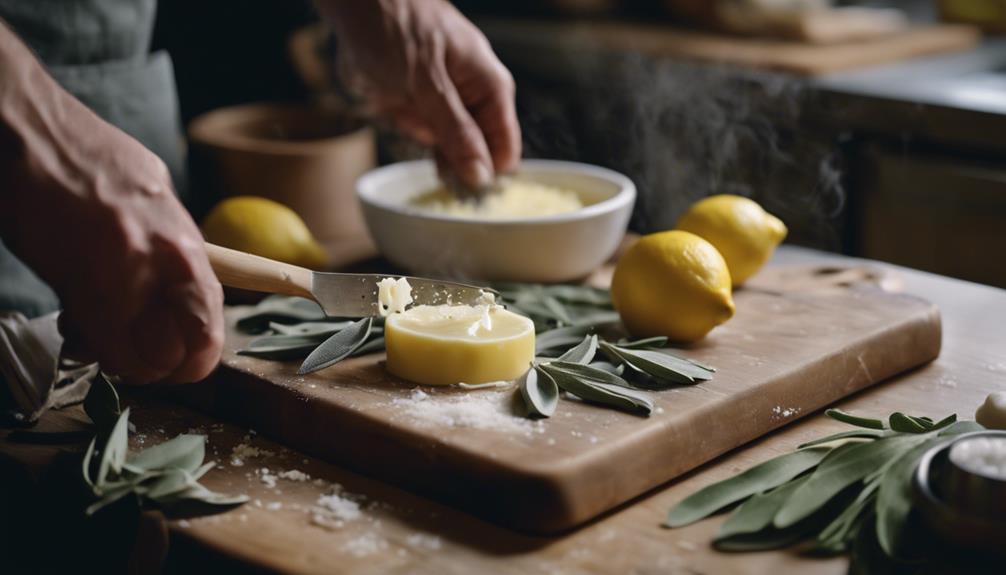
Spice up your sage butter by experimenting with additional herbs like rosemary, thyme, or garlic for a delightful twist. These additions can elevate your sauce recipe, making it more versatile and flavorful.
Imagine the rich, savory blend when you incorporate grated parmesan and a hint of red pepper flakes into your sage butter. This combination adds a nutty, spicy kick that perfectly complements pasta, roasted vegetables, or grilled meats.
You can also customize the flavor profile by including other ingredients:
- Lemon zest and black pepper: Add an invigorating citrus note and a subtle heat.
- Chopped nuts like walnuts or pecans: Introduce a crunchy texture and deep, nutty flavor.
- Flavored salts or infused oils: Enhance the taste with unique combinations like truffle salt or basil oil.
These simple tweaks can transform your sage butter into a multi-dimensional condiment that's perfect for nearly any dish.
Don't be afraid to get creative and try different combinations. You might discover a new favorite that you'll want to make again and again.
Have fun experimenting and enjoy the delicious results!
Expert Tips
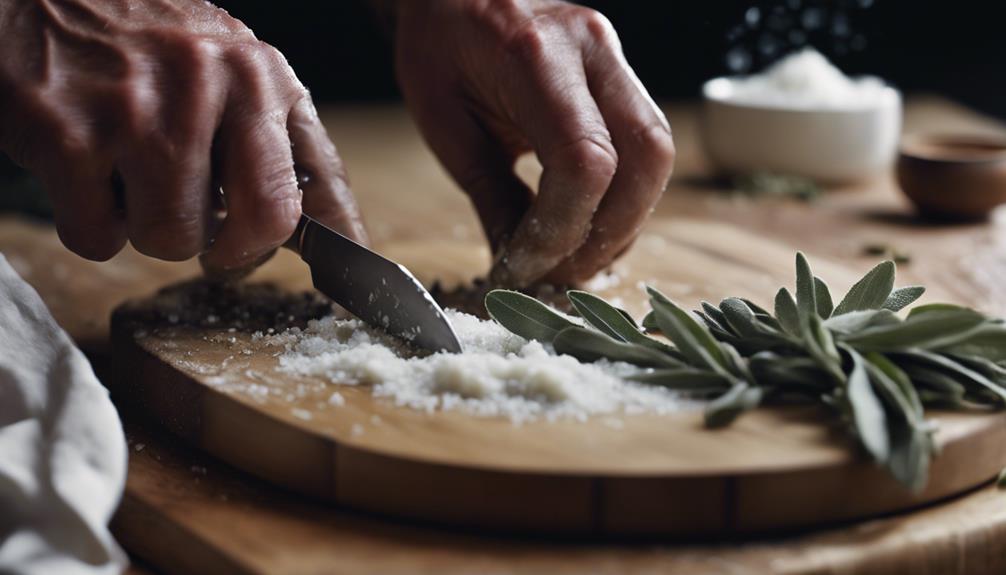
To elevate your sage butter, start by choosing the freshest ingredients for the best flavor.
Master your mixing techniques to guarantee a smooth, even blend.
Fresh Ingredient Selection
When selecting sage for your butter, choose leaves that are vibrant, aromatic, and free from any signs of wilting or browning. Fresh sage leaves with a vibrant color and strong fragrance are essential for achieving the best flavor. The oils in these leaves provide a distinctive earthy and peppery taste that will elevate your sage butter to new heights.
To make sure you're getting the freshest possible sage, keep these tips in mind:
Inspect the leaves: Look for a vibrant green hue and avoid any that appear dull or have brown spots.
Smell the sage: Fresh leaves should have a strong fragrance that's both earthy and peppery. If the scent is faint, the flavor will be too.
Consider the source: Opt for organic or locally sourced sage leaves. These are often fresher and more environmentally friendly.
Mixing Techniques Explained
Now that you've chosen the freshest sage, it's time to master the mixing techniques to create perfectly blended sage butter. Start by using unsalted butter, which should be softened at room temperature.
Add your chopped sage to the softened butter and use a hand mixer on low speed. This guarantees a smooth, even blend without overworking the butter.
While mixing, gradually incorporate salt and pepper. Doing this slowly helps distribute the flavors evenly throughout the sage butter. Be careful not to overmix, as this can make the butter too soft and cause it to lose its desirable texture.
For a more rustic appearance, try folding the chopped sage into the butter rather than using a mixer. This approach adds a charming, homemade look to your sage butter.
Once mixed, refrigerate the sage butter for at least an hour. This chilling period allows the flavors to meld and intensify, giving you a more robust taste when you're ready to use it.
Storage and Usage
Storing sage butter correctly guarantees it maintains its flavor and texture, ready for whenever you need a burst of herbal richness in your dishes. For best storage, place your sage butter in a zip-lock bag and keep it in the freezer. This method not only preserves the flavor but also maximizes accessibility when you're ready to use it.
When it's time to incorporate sage butter into your cooking, simply thaw it at room temperature. If you need it softened quickly, just leave it out for a bit.
Here are some practical tips for using your sage butter:
- Cornbread muffins: Spread a generous amount of sage butter on warm cornbread muffins for an elevated, savory taste.
- Potato rolls: Enhance the flavor of your potato rolls by brushing them with melted sage butter before serving.
- Mashed sweet potatoes: Stir in some sage butter into mashed sweet potatoes for a delightful herbal twist.
Feel free to experiment with different herbs to create unique variations of flavored butter. This way, you can always have a customized burst of flavor ready to elevate your culinary creations.
Proper storage and thoughtful usage will maximize your sage butter remains a versatile and delicious addition to your kitchen.
Frequently Asked Questions
What Is Sage Butter Made Of?
You make sage butter with softened butter, finely minced sage leaves, and a pinch of salt. For extra flavor, add white pepper. Mix it all together and let it sit at room temperature to meld the flavors.
How Long Does Sage Butter Last?
Sage butter lasts up to 2 weeks in the refrigerator and up to 3 months in the freezer. Always store it in an airtight container, check for spoilage signs, and enjoy it within these time frames for best quality.
How Do You Preserve Sage Butter?
To preserve sage butter, freeze it in a tube or individual pats. Wrap it in wax or parchment paper, then store it in a zip-lock bag. It'll last up to three months in the freezer without losing flavor.
What Is a Good Substitute for Sage in Brown Butter?
Did you know 70% of home cooks prefer thyme as their herb substitute? You can use fresh thyme in brown butter for an earthy, aromatic flavor. It's a great alternative that complements many dishes beautifully.
Conclusion
You've now mastered the art of making sage butter, a simple yet transformative ingredient. While store-bought butter might be convenient, your homemade sage butter brings a rich, aromatic depth that's unparalleled.
Whether you're freezing it for later or using it fresh, the burst of flavor it adds to your dishes is extraordinary. Experiment with variations, trust your taste buds, and elevate your cooking effortlessly.
Homemade always trumps store-bought – and your dishes will prove it.
